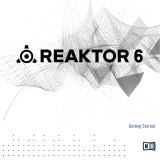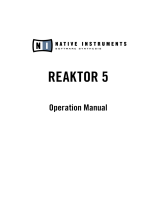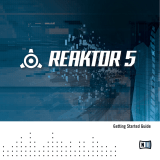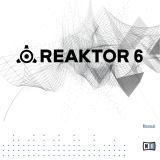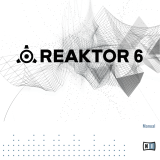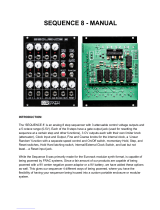Page is loading ...


The information in this document is subject to change without notice and does not represent a
commitment on the part of Native Instruments GmbH. The software described by this docu-
ment is subject to a License Agreement and may not be copied to other media. No part of this
publication may be copied, reproduced or otherwise transmitted or recorded, for any purpose,
without prior written permission by Native Instruments GmbH, hereinafter referred to as Native
Instruments.
“Native Instruments”, “NI” and associated logos are (registered) trademarks of Native Instru-
ments GmbH.
Mac, Mac OS, GarageBand, Logic, iTunes and iPod are registered trademarks of Apple Inc.,
registered in the U.S. and other countries.
Windows, Windows Vista and DirectSound are registered trademarks of Microsoft Corporation
in the United States and/or other countries.
All other trade marks are the property of their respective owners and use of them does not im-
ply any affiliation with or endorsement by them.
Document authored by: Jan Ola Korte
Software version: 1.3 (05/2017)
Disclaimer

NATIVE INSTRUMENTS GmbH
Schlesische Str. 29-30
D-10997 Berlin
Germany
www.native-instruments.de
NATIVE INSTRUMENTS North America, Inc.
6725 Sunset Boulevard
5th Floor
Los Angeles, CA 90028
USA
www.native-instruments.com
NATIVE INSTRUMENTS K.K.
YO Building 3F
Jingumae 6-7-15, Shibuya-ku,
Tokyo 150-0001
Japan
www.native-instruments.co.jp
NATIVE INSTRUMENTS UK Limited
18 Phipp Street
London EC2A 4NU
UK
www.native-instruments.co.uk
© NATIVE INSTRUMENTS GmbH, 2017. All rights reserved.
Contact

Table of Contents
1 Welcome to REAKTOR Blocks .....................................................................................
8
1.1 About the Blocks Documentation ................................................................................................ 10
1.1.1 Info Hints ................................................................................................................... 11
1.1.2 Blocks Framework Manual ......................................................................................... 12
1.1.3 Document Conventions .............................................................................................. 13
1.2 Where to Start? ........................................................................................................................... 14
1.3 Further Reading .......................................................................................................................... 16
2 Basic Workflow .........................................................................................................
17
2.1 Play Mode vs. Edit Mode ............................................................................................................. 18
2.2 Navigating between Panel and Structure ................................................................................... 18
2.3 Saving Patches and Parameter Settings .................................................................................... 20
2.3.1 Saving and Loading Ensembles in the Stand-Alone Application ................................ 20
2.3.2 Saving and Loading Ensembles in the Plug-in .......................................................... 21
2.3.3 Storing and Recalling Snapshots .............................................................................. 22
2.4 Adding Blocks to a Patch ............................................................................................................ 25
2.5 Organizing and Arranging Blocks ............................................................................................... 26
3 Patching in Blocks ....................................................................................................
29
3.1 Making Connections ................................................................................................................... 30
3.2 Panel Controls ............................................................................................................................ 31
3.3 Modulation Routing .................................................................................................................... 33
4 Connections and Signals ...........................................................................................
36
4.1 General Inputs and Outputs ....................................................................................................... 39
4.2 Modulation ................................................................................................................................. 41
4.3 Pitch ........................................................................................................................................... 42
4.4 Gate ............................................................................................................................................ 43
Table of Contents
REAKTOR BLOCKS - Manual - 4

4.5 Reset .......................................................................................................................................... 45
4.6 Play ............................................................................................................................................ 46
4.7 Sync ............................................................................................................................................ 47
4.8 Pluck .......................................................................................................................................... 48
5 Blocks Reference ......................................................................................................
49
5.1 Bento Box ................................................................................................................................... 49
5.1.1 VCA (AMP) ................................................................................................................. 49
5.1.2 SVF (FLT) ................................................................................................................... 52
5.1.3 Mix (MIX) ................................................................................................................... 55
5.1.4 XFade (MIX) ............................................................................................................... 57
5.1.5 ADSR Envelope (MOD) ................................................................................................ 59
5.1.6 LFO (MOD) ................................................................................................................. 61
5.1.7 Oscillator (OSC) ......................................................................................................... 63
5.1.8 CV Processor (PRO) .................................................................................................... 66
5.1.9 Sample & Hold (PRO) ................................................................................................. 69
5.1.10 4 Mods (SEQ) ............................................................................................................. 72
5.1.11 8 Steps (SEQ) ............................................................................................................ 75
5.2 Boutique ..................................................................................................................................... 79
5.2.1 Dual SKF (FLT) ........................................................................................................... 79
5.2.2 Multiwave OSC (OSC) ................................................................................................ 80
5.2.3 OSC 5 (OSC) .............................................................................................................. 81
5.3 Digilog ........................................................................................................................................ 82
5.3.1 Quantizer (PRO) ......................................................................................................... 82
5.3.2 Clock Divider (PRO) ................................................................................................... 83
5.4 DRIVER ....................................................................................................................................... 84
5.4.1 DRIVER (EFX) ............................................................................................................. 84
Table of Contents
REAKTOR BLOCKS - Manual - 5

5.5 Kodiak ........................................................................................................................................ 85
5.5.1 Curve Sequencer ........................................................................................................ 85
5.5.2 Duality Osc ................................................................................................................ 87
5.5.3 Flip Gen ..................................................................................................................... 89
5.5.4 Morph Filter ............................................................................................................... 90
5.5.5 Shift Sequencer ......................................................................................................... 92
5.6 Modern ....................................................................................................................................... 94
5.6.1 Paul Filter (FLT) ......................................................................................................... 94
5.6.2 Comb Filter (FLT) ....................................................................................................... 96
5.7 MONARK ..................................................................................................................................... 97
5.7.1 MONARK Filter (FLT) ................................................................................................... 97
5.7.2 MONARK ADS ENV (MOD) ........................................................................................... 98
5.7.3 MONARK Oscillator (OSC) .......................................................................................... 99
5.8 ROUNDS ...................................................................................................................................... 100
5.8.1 ROUNDS Delay (EFX) .................................................................................................. 100
5.8.2 ROUNDS Reverb (EFX) ................................................................................................ 101
5.8.3 ROUNDS LFO (MOD) ................................................................................................... 102
5.9 Util ............................................................................................................................................. 103
5.9.1 Scope (AUX) ............................................................................................................... 103
5.9.2 Clock (INT) ................................................................................................................. 104
5.9.3 Gates & Trigs (INT) .................................................................................................... 105
5.9.4 Macro Knobs (INT) ..................................................................................................... 107
5.9.5 Macro Switches (INT) ................................................................................................. 108
5.9.6 MIDI Out (INT) ............................................................................................................ 109
5.9.7 Note In (INT) .............................................................................................................. 111
5.9.8 Pitch CV Out (INT) ...................................................................................................... 112
Table of Contents
REAKTOR BLOCKS - Manual - 6

5.9.9 Trig In (INT) ............................................................................................................... 120
5.9.10 CV Mix (MIX) .............................................................................................................. 121
5.9.11 Level Mono (MIX) ....................................................................................................... 122
5.9.12 Level Stereo (MIX) ...................................................................................................... 123
5.9.13 Mix 4 (MIX) ................................................................................................................ 124
5.10 West Coast ................................................................................................................................. 125
5.10.1 LPG (FLT) ................................................................................................................... 125
5.10.2 CFG (MOD) ................................................................................................................. 126
5.10.3 DWG (OSC) ................................................................................................................. 127
5.10.4 XYS (SEQ) .................................................................................................................. 128
Table of Contents
REAKTOR BLOCKS - Manual - 7

1 Welcome to REAKTOR Blocks
REAKTOR Blocks brings the experience of patching an analog modular synthesizer to REAK-
TOR 6, adding unique features only possible in software. As a self-contained system, it is com-
posed of common building blocks found in contemporary modular synthesizers.
Unlike a regular synthesizer with a fixed architecture, a modular synthesizer does not predefine
a specific arrangement for these building blocks. You can freely arrange and connect them to
facilitate a wide range of different synthesis methods, or find completely new ways of generat-
ing sound.
Blocks patches can be created without prior building experience in REAKTOR. Universal con-
nectivity between all Blocks allows for any connection to be made, with predictable results.
Many features commonly associated with analog modular synthesizers, like feedback connec-
tions and audio rate modulation, have been thoroughly implemented to not only function cor-
rectly across all modules, but also sound great.
REAKTOR Blocks are based on a sophisticated framework that provides the infrastructure
needed to bring together the user interface, the unified connection scheme, and the underlying
signal processing. To support builders who want to contribute new Blocks to the format, an
elaborate building template has been created and uploaded to the REAKTOR User Library on
our website. Download it here.
Patching, Building, and Sharing
By combining an intuitive user interface with straight-forward patching, immaculate DSP algo-
rithms and a powerful framework, REAKTOR Blocks benefits musicians and builders alike:
• The unified connection scheme allows sound designers and musicians without building
experience to dive into the Structure and create their own instruments and effects.
• REAKTOR Primary builders can make a smooth transition to Core by modifying the under-
lying Core Cells or using buildings blocks from the Core Macro Library.
• REAKTOR Core builders can use the framework and Panel templates to create new Blocks
by integrating their own custom Core Cells.
Welcome to REAKTOR Blocks
REAKTOR BLOCKS - Manual - 8

REAKTOR is fortunate to be supported by a large community of experienced users who actively
share their creations in the REAKTOR User Library on our website —a great source of inspira-
tion, both musically and technologically. We invite you to join this vibrant community and are
looking forward to seeing and hearing your patches and Blocks!
A REAKTOR Blocks patch
Welcome to REAKTOR Blocks
REAKTOR BLOCKS - Manual - 9

1.1 About the Blocks Documentation
This manual gives an overview over the basic workflows in Blocks (see section ↑2, Basic Work-
flow) and gets you started with patching (see section ↑3, Patching in Blocks). You will also find
a detailed description of the unified connection scheme in Blocks (see section ↑4, Connections
and Signals). Finally, all Blocks are described in detail, allowing you to make yourself familiar
with their general functionality as well as their controls, inputs, and outputs (see section ↑5,
Blocks Reference).
While most of the instructions in this manual do not require prior knowledge about REAKTOR,
it is recommended to read the REAKTOR 6 documentation to get a better understanding of the
underlying concepts and features.
►
To access the REAKTOR 6 documentation, open the Help menu in the REAKTOR menu
bar:
Welcome to REAKTOR Blocks
About the Blocks Documentation
REAKTOR BLOCKS - Manual - 10

1.1.1 Info Hints
Blocks features comprehensive information about the Blocks as well as their controls, inputs,
and outputs in the REAKTOR application. You can view this information in the form of tooltips
(called Info Hints in REAKTOR).
►
To show the Info Hints in REAKTOR, enable the Show Info Hints option in the Toolbar.
Info Hints are available for each entire Block, the individual controls, as well as the inputs and
outputs.
►
To view the Info Hint for a Block, place the mouse over its header:
►
To view the Info Hint for a parameter, place the mouse over its Panel control:
►
To view the Info Hint for an input or output, place the mouse over the port in the Struc-
ture.
Welcome to REAKTOR Blocks
About the Blocks Documentation
REAKTOR BLOCKS - Manual - 11

1.1.2 Blocks Framework Manual
In every Block, a sophisticated framework provides the infrastructure needed to bring together
the user interface, the unified connection scheme, and the underlying signal processing.
To support builders who want to contribute new Blocks to the format, an elaborate building
template has been created and uploaded to the REAKTOR User Library on our website. Down-
load it here.
The template includes all components needed to create fully compatible Blocks based on your
own designs. It features a comprehensive manual that explains all the specifics of the frame-
work, allowing for a smooth transition into building your own Blocks.
The Blocks Template in REAKTOR
Welcome to REAKTOR Blocks
About the Blocks Documentation
REAKTOR BLOCKS - Manual - 12

1.1.3 Document Conventions
This section introduces you to the signage and text highlighting used in this manual.
• Text appearing in (drop-down) menus (such as Open…, Save as… etc.) and paths to loca-
tions on your hard disk or other storage devices is printed in italics.
• Text appearing elsewhere (labels of buttons, controls, text next to checkboxes etc.) is
printed in blue. Whenever you see this formatting applied, you will find the same text ap-
pearing somewhere on the screen.
• Important names and concepts are printed in bold.
• References to keys on your computer’s keyboard you’ll find put in square brackets (e.g.,
“Press [Shift] + [Enter]”).
►
Single instructions are introduced by this play button type arrow.
→
Results of actions are introduced by this smaller arrow.
Furthermore, this manual uses particular formatting to point out special facts and to warn you
of potential issues. The icons introducing these notes let you see what kind of information is to
be expected:
The speech bubble icon indicates a useful tip that may often help you to solve a task
more efficiently.
The exclamation mark icon highlights important information that is essential for the giv-
en context.
The red cross icon warns you of serious issues and potential risks that require your full
attention.
Welcome to REAKTOR Blocks
About the Blocks Documentation
REAKTOR BLOCKS - Manual - 13

1.2 Where to Start?
Blocks in the REAKTOR 6 Library
Blocks is part of the REAKTOR Library, which can be found in the Browser tab of the Side
Pane. The available Blocks are organized in folders, grouping them into different lines:
• Bento Box: Core components of a modular synthesizer, enhanced with special features.
• Boutique: Boutique Blocks are inspired by great synthesizers of the past.
• Digilog: Sequencing tools for note processing, complex rhythms, and musical structures.
• Driver, Monark, Rounds: Components from well-known NI products, available in Blocks.
• Kodiak: Forward-thinking Blocks based on advanced software concepts.
• Modern: State-of-the-art Blocks with a contemporary twist.
• Util: Utilities that provide the infrastructure for your patches.
• West Coast: West Coast Blocks are inspired by the Buchla tradition of synthesizers.
Welcome to REAKTOR Blocks
Where to Start?
REAKTOR BLOCKS - Manual - 14

The ‘New’ Ensemble
Ensembles are the basic project files in REAKTOR that hold all relevant information of a ses-
sion. Blocks patches are based on a dedicated ‘New’ Ensemble, containing a few basic mod-
ules that are often used to support patches in terms of note input, clocking, and audio output.
More importantly, this Ensemble includes optimizations for the automation handling and the
Panel view that are required for Blocks.
►
To open the ‘New’ Ensemble, select the Reaktor Blocks folder in the Library and double-
click on the Blocks New.ens Ensemble in the lower section of the Browser (alternatively,
you can click and drag it into REAKTOR’s main area).
→
A new Ensemble opens, specifically set up for hosting Blocks patches.
REAKTOR Blocks comes with a selection of pre-built patches (REAKTOR Ensembles)
and many presets (REAKTOR Snapshots) that are ready to be used in your music and
sound design projects. These Ensembles can be directly accessed from the MASCHINE
or KOMPLETE KONTROL Browser, or you can load them from the Reaktor Blocks folder
in the Player tab of the REAKTOR Browser (see section ↑3, Patching in Blocks).
Welcome to REAKTOR Blocks
Where to Start?
REAKTOR BLOCKS - Manual - 15

1.3 Further Reading
If you are new to modular synthesis, or want to expand your knowledge about patching techni-
ques and the technology involved, the following online resources can be of great help.
The websites linked below are owned and operated by third parties. The links are provid-
ed for your information and convenience only. Native Instruments has no control over
the contents of any of the linked websites and is not responsible for these websites or
their content or availability.
• Sound On Sound Synthesizer Secrets: This extensive collection of excellent articles by
Gordon Reid covers many different synthesis techniques, explaining how they can be used
to create classic synthesizer sounds or mimic acoustical instruments.
• Rob Hordijk’s Synthesis Workshops: Rob Hordijk’s Synthesis Workshops are among the
best reads on sound synthesis available online. The articles and tutorials are very well
structured and cover synthesizer theory, history, and practice in great detail.
• Basics of Sounds Synthesis: Another helpful resource from Rob Hordijk, covering some of
the more basic topics from his Synthesis Workshops in a concise manner. This is espe-
cially useful as an introductory document for beginners.
• Advanced Programming Techniques for Modular Synthesizers: This online book by James
J. Clark explains many different advanced synthesis methods and how they can be patch-
ed up with a modular synthesizer.
• Muffwiggler Forum: Renowned not only for its odd name, the largest online community for
modular synthesis is undoubtedly the central hub of the scene, and a useful source of in-
formation. It is highly recommended to use the search engine, which is very well-featured.
Welcome to REAKTOR Blocks
Further Reading
REAKTOR BLOCKS - Manual - 16

2 Basic Workflow
In Blocks, you use wires to connect any number of individual Blocks to form a patch, a higher-
level structure that constitutes a musical instrument, a sequencer, an effect, or any combina-
tion thereof. Each Block takes on a specific role in this structure. This does not mean each
Block always performs the same function. While they all have an intended purpose, Blocks can
be misused in interesting ways. There are no wrong connections in Blocks, and unusual patch-
es often lead to surprising results.
Technically, Blocks are REAKTOR Instruments (REAKTOR .ism file format), and a patch con-
sisting of multiple Blocks is hosted in a REAKTOR Ensemble (REAKTOR .ens format). Connec-
tions are made in the Structure, while the parameters are controlled on the Panel. The Panel is
independent from the Structure, so the arrangement can be optimized for playing with your
Blocks patch.
(1) Panel: The Panel is where you change the Blocks’ parameters and tweak your sounds.
(2) Structure: The Structure is where you connect the Blocks’ inputs and outputs.
(3) Side Pane: The Side Pane hosts the Browser and additional settings like the Snapshots.
Basic Workflow
REAKTOR BLOCKS - Manual - 17

2.1 Play Mode vs. Edit Mode
You can play your patch and control its parameters in REAKTOR’s Play mode, however if you
want to add Blocks to your patch, change its Structure, or edit some of its advanced settings,
you have to enable Edit mode.
►
To toggle Edit Mode on or off, click on the EDIT button in REAKTOR's toolbar.
2.2 Navigating between Panel and Structure
You can switch between the Panel and the Structure using so-called Breadcrumps in the navi-
gation bar at the top of REAKTOR’s main area.
►
To view the Panel, click on the Panel Breadcrump in the navigation bar.
►
To view the Structure, click on the Breadcrump carrying the name of the Ensemble in the
navigation bar.
Basic Workflow
Play Mode vs. Edit Mode
REAKTOR BLOCKS - Manual - 18

Split View
You can also use REAKTOR’s split view to view both the Panel and the Structure at the same
time:
A patch in REAKTOR Blocks, viewed in split view
►
To enable split view, click on the Horizontal Split or Vertical Split buttons in the upper-
right corner of REAKTOR’s main area.
Basic Workflow
Navigating between Panel and Structure
REAKTOR BLOCKS - Manual - 19

2.3 Saving Patches and Parameter Settings
All connections between Blocks and their arrangement in the Structure are saved in the En-
semble, so you have to save a new Ensemble for each of your patches (see section ↑2.3.1, Sav-
ing and Loading Ensembles in the Stand-Alone Application).
The parameter settings on the Panel can be saved in presets, called Snapshots in REAKTOR.
You can create global Snapshots for all Blocks in a patch at once, on the Ensemble level, or
individual Snapshots for each Block, on the Instrument level. This allows you to save several
sets of settings for a patch and recall them in an instant (see section ↑2.3.3, Storing and Re-
calling Snapshots).
2.3.1 Saving and Loading Ensembles in the Stand-Alone Application
In the REAKTOR stand-alone application, you can save and load Ensembles from the main
menu in the Tool Bar.
►
To open the main menu, click on the arrow next to the REAKTOR logo.
Alternatively, you can use the Files tab in the REAKTOR Browser to browse for your En-
sembles and load them by drag and drop, or by double-clicking.
Basic Workflow
Saving Patches and Parameter Settings
REAKTOR BLOCKS - Manual - 20
/

